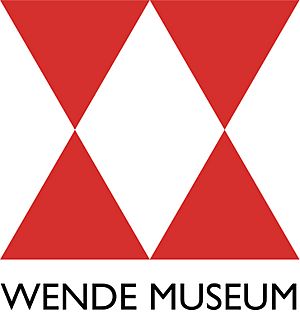Wende Museum facts for kids
 |
|
| Established | 2002 |
|---|---|
| Location | 10808 Culver Blvd, Culver City, CA 90230 |
| Type | Cultural Museum |
The Wende is a special place in Culver City, California. It is an art museum, a cultural center, and a huge collection of historical items, like an archive. The museum helps us learn about a time called the Cold War.
What Does "Wende" Mean?
The word Wende (pronounced venda) comes from German. It means "transformation" or "change." This name refers to a big time of change in history. This was when the Berlin Wall fell in 1989. It also includes the time when the Soviet Union broke apart in 1991.
The Wende Museum started in 2002. It has one of the largest collections of art and artifacts from the Cold War era. This was a period of tension between different countries.
Fun Programs and Events
The Wende Museum offers many exciting programs for everyone. It used to be mainly for researchers. Now, it's a cultural place for all ages. It brings together art and history in fun ways.
In 2024, the museum opened the Glorya Kaufman Community Center. This center has three stories. Here, the Wende and other groups offer free cultural and educational programs. The Glorya Kaufman Community Center was even called one of the "8 Best New Architecture Projects in L.A. for 2024."
Some of the cool things you can do at the Wende include:
- See amazing art shows and exhibits.
- Listen to interesting talks and discussions.
- Enjoy music, dance, and theater shows.
- Take school tours to learn more.
- Join "Family Day" activities for all ages.
- Participate in online discussion groups.
In 2024, the Wende also joined a big art event called Getty’s PST Art. They had an exhibition called Counter/Surveillance: Control, Privacy, Agency.
Amazing Collections
The Wende's collections help us learn about countries from the Cold War. These include former East Bloc countries, the Soviet Union, China, Vietnam, North Korea, and Cuba. The museum helps people study art, culture, and history.
The collection has many different items, such as:
- Everyday items like computers, radios, and records.
- Modern art, including paintings, drawings, and sculptures.
- Important political items like statuary, medals, and flags.
- Old films, including 3,500 16mm documentary and animation films.
- Furniture, banners, and communist folk art.
- Items from Soviet Jewish communities.
- Materials from Russian hippies in the 1960s and 1970s.
- Artifacts from the former KGB Espionage Museum.
The museum also has many recorded stories from people who lived through these times. These are called oral histories.
Some of the museum's East German collections are featured in books. These books are Beyond the Wall: Art and Artifacts from the GDR and The East German Handbook.
The Wende's collections have been shown in many other museums. These include the Los Angeles County Museum of Art and the International Spy Museum.
How the Museum Started
The Wende Museum was started in 2002 by Justinian (Justin) Jampol. He grew up in Los Angeles. He is also a scholar who studies European history.
For over ten years, the museum was in an office park. In 2012, the City Council of Culver City made a big decision. They approved a 75-year lease for the former United States National Guard Armory building. This building became the Wende Museum's permanent home.
The Armory building was built in 1949. This was when the Cold War was starting. It stopped being used by the National Guard in 2011. After some renovations, the Wende Museum opened there in November 2017.
The Wende's campus is one acre big. It includes the museum, beautiful gardens, and the Glorya Kaufman Community Center. In the garden, there is an old East German guardhouse. This guardhouse used to control who could enter the state news agency. Now, artists use it to create new art. These artworks explore ideas about communication and power today.

